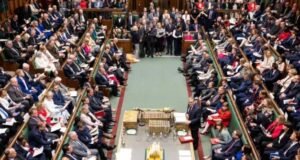 A new house under construction at Taylor Wimpey’s Churchill Place development in Mill Hill, London. The current rate of 150,000 new homes a year is far short of government targets. Photograph: Yui Mok/PA
A new house under construction at Taylor Wimpey’s Churchill Place development in Mill Hill, London. The current rate of 150,000 new homes a year is far short of government targets. Photograph: Yui Mok/PA
Britain’s biggest housebuilders possess enough land to create more than 600,000 new homes, an analysis by the Guardian has found, raising questions about whether they are doing enough to solve the housing crisis facing Britain.
The nine housebuilders in the FTSE 100 and FTSE 250 hold 615,152 housing plots in their landbank, according to financial disclosures. This is four times the total number of homes built in Britain in the past year.
Berkeley, Barratt, Persimmon and Taylor Wimpey – the four biggest companies in the industry – account for more than 450,000 of the plots. They are also sitting on £947m of cash and declared or issued more than £1.5bn in payouts to shareholders in 2015.
Shelter said the figures showed how dysfunctional the housing market has become. Toby Lloyd, head of policy for the housing charity, said: “Developers do need a pipeline of future sites – but when housebuilding is still stubbornly low and landbanks are this large it is a signal of how dysfunctional our housebuilding system is.
A modern housing estate in Norfolk. Housebuilders are leaving hundreds of thousands of plots idle, according to records. Photograph: David Burton/Alamy
“These are private companies so it’s reasonable for them to seek profits. But when their profits are so high we should be questioning why the government is directing subsidies towards developers to build barely affordable starter homes and away from providing the genuinely affordable housing we so desperately need.” Under Ed Miliband, Labour floated the idea of a use-it-or-lose-it policy for companies sitting on undeveloped land.
Advertisement
George Osborne warned in the autumn statement that there was a “growing crisis of home ownership in our country”. He unveiled plans to boost housebuilding by offering £2bn of public funds towards supporting projects, releasing public land suitable for 160,000 homes, and introducing a new London help-to-buy scheme for first-time buyers struggling to afford a property.
The government wants to build 1m new homes in England by 2020. This would mean building 200,000 a year, but the existing construction levels of just over 150,000 are well behind that. Despite the fact the nine listed housebuilders hold more than 600,000 housing plots, they sold just 66,881 homes between them in their last financial year.
However, their profits and share prices are booming as they enjoy the benefits of snapping up land cheaply and the average selling price of their property rises. The housebuilders include the four FTSE 100 companies along with Bellway, Bovis, Crest Nicholson, Galliford Try and Redrow.
The government insisted it was not complacent about the housing shortage facing Britain and that housebuilders should be playing their part. A Department for Communities and Local Government spokesman said: “We want to ensure anyone who aspires to own their own home has the opportunity to do so. Our reforms have got Britain building again with the number of new homes up 25% in the last year.
“But we are far from complacent and have recently doubled the investment in housing to support the largest housing programme by any government since the 1970s. Housebuilders too should be playing their part to ensure we deliver the homes this country needs.”
The land held by housebuilders includes sites they own and sites that they have an contractual option to build on. Some housebuilders do not publicly disclose all the land they control, meaning their total landbank could be even bigger. For example, Bellway does not report land that has not got planning permission for house construction, while Persimmon says it controls 18,000 acres of “strategic land” on top of more than 90,000 plots that already have planning permission.
George Osborne said he wanted to see 1m new homes built in Britain by 2020. Photograph: Toby Melville / Reuters/Reuters
The Guardian’s findings are based on information disclosed in the companies’ last financial results. The housebuilders defended the size of their landbanks and the pace of construction. They claimed that problems in winning planning permission and limited demand in some areas of the country meant they could not build any faster.
John Stewart, director of economic affairs at the Home Builders Federation, said: “Over the past few years housebuilding has increased output at the steepest rate for decades with the most recent figures showing a 25% year on year increase in housing supply. The industry is recruiting and training tens of thousands of new people to ensure it can continue to deliver significant sustainable increases and provide the high quality homes the country needs.”
Berkeley, whose chairman, Tony Pidgley, netted a £23m payout in 2015, said the company was building on all sites that have an “implementable planning consent”. In a statement, the London-focused company said cuts to local planning departments was partly to blame for the fact that it was not building faster: “The challenge is often around getting conditions cleared for development, particularly on major regeneration sites, and the capacity within local planning authorities to work alongside us. In London, planning departments have been cut by more than 50% over the last five years.”
Barratt said it was building 40% more homes than four years ago, when the industry was still recovering from the financial crisis, but that shortages of skilled workers and materials were hampering progress. “This has been achieved whilst overcoming a number of well-publicised housing market challenges, particularly brick and labour shortages,” a spokesman said.
Despite initiatives such as help to buy, critics say realistic numbers of affordable homes are simply not being created. Photograph: Christopher Furlong/Getty Images
“We have an extensive programme of recruitment and we now have more apprentices in training than at any time since 2007. We have virtually no sites that have an implementable planning consent that are not in production.’’
Taylor Wimpey also pinpointed the “slow and complex” planning process and said all sides of the housing debate needed to be patient if more homes were to be built. A spokesman said: “As one of the UK’s largest housebuilders, Taylor Wimpey is committed to delivering quality and much-needed homes across the UK through the housing cycle and it is pleasing to see the government’s continued commitment to housing delivery.
“Whilst it is improving, the planning process is slow and complex and a number of conditions need to be fulfilled before development can commence on our sites. A shortage of resources in planning departments also often means that delays occur in this process. We therefore need to be patient and constructive on all sides of the debate in order to sustainably build the homes that the country needs. We continue to work closely with local authorities and communities to secure planning approval and as soon as we have an implementable permission we begin development without delay.”
 Weekly Bangla Mirror | Bangla Mirror, Bangladeshi news in UK, bangla mirror news
Weekly Bangla Mirror | Bangla Mirror, Bangladeshi news in UK, bangla mirror news







